IDP News Issue No. 15
Mannerheim's Central Asian Expedition of 1906-1908
Alpo Ratia
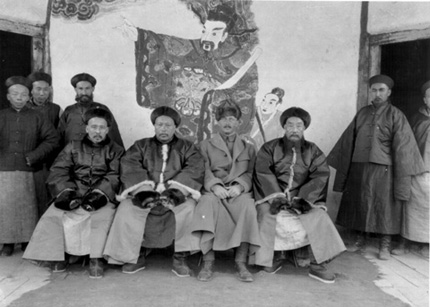
Right:Mannerheim with local Aksu officials Photograph property of the National Board of Antiquities/Finno-Ugrian Society Exhibition: Mannerheim in Central Asia 1906-1908 in the Museum of Cultures
By the turn of the nineteenth century the focus of international Orientalist interest had shifted from the Near East to Central Asia. Leading Orientalists led expeditions in search of hidden treasure along the Silk Road in Chinese Turkestan. At the same major powers (Great Britain, Japan and Russia) sought to enlarge their respective sphere of influence and sent agents there, sometimes in the guise of scientific explorers.
The Russian General Staff commissioned a Finn, Baron Carl Gustaf Mannerheim (1867-1951), a talented cavalry officer in imperial service, to undertake a military intelligence-gathering mission through China's northern provinces. The aim was to map certain routes, verify the population census in these provinces, investigate the progress made in modernizing the military, administrative and educational systems, and also to ascertain the political aspirations and divisions among non-Chinese and Chinese: in short, to assess China's defence capacity and Russia's strategic options.
Keen also to promote science in the Grand Duchy of Finland, Mannerheim contacted Senator Otto Donner (1835-1909) and through his good offices negotiated with the Finno-Ugrian Society and with trustees of the Antell Fund. Mannerheim was asked to copy inscriptions, purchase ancient manuscripts, archaeological and ethnographical artefacts, make anthropometric measurements, photograph racial types, and collect ethnographic and linguistic material about the little known peoples of North China.
The Society placed funds at Mannerheim's disposal, while the Antell trustees set funds aside for the State Historical Museum (later renamed the National Museum) to purchase antiquities and ethnographic items from Mannerheim. However, because Chinese culture was deemed to be well-known, 'Han' materials were excluded.
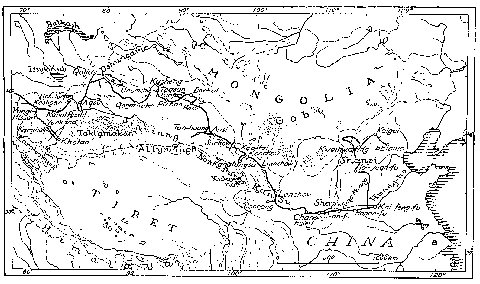
Left:Map of Mannerheim's journey across Asia Helsinki: Finno-Ugrian Society, 1940.
Mannerheim's Central Asian expedition lasted nearly two years (29 July 1906 to 20 July 1908). He set off from Andizhan in Russian Turkestan and, in stages, traversed China's Xinjiang, Gansu, Shaanxi and Shanxi provinces on his way to Kalgan near Beijing (see map below). The journey, about 14,000 km, was made mainly on horseback and Mannerheim was accompanied by two Cossacks, a Chinese interpreter, a cook, and several caravan men.
Mannerheim's ancient manuscript and archaeological acquisitions, such as they are, came solely from Xinjiang. Antiquities purchased from local treasure hunters on the southern route in the Khotan area included 76 coins, a small number of text fragments in Sanskrit and Khotanese, engraved gems and terracotta artefacts. At Kelpin, on the north-west edge of the Taklamakan, Mannerheim tried his hand at excavation, but without marked success. While passing through Torgut and Kirghiz areas he photographed numerous inscriptions and rock-drawings. At Kuldja and on the Northern Silk Road at Karashahr he carried out minor excavations and recovered some potsherds. Further east in the Turfan area he made excursions to the sites of Yarkhoto, Idiqut Shahri and Chiktym, but was so dismayed by the mutilations wrought by contemporary archaeologists that he refrained from all further excavation. Nevertheless, he purchased artefacts and a sizeable number (1971) of text fragments in Chinese, as well as documents in Uighur and Middle Persian from locals. These had presumably been found in ruins near Turfan.
The Mystery of a Missed Opportunity

Mannerheim's journey continued south-eastwards along the edge of the desert. In October 1907 his path crossed that of Aurel Stein's caravan at Hami [Mannerheim's letter from Lanzhou dated 17 February 1908 to Senator Donner quoted in Pirjo Varjola (ed.), C. G. Mannerheim in Central Asia, 1906-8, National Board of Antiquities, Helsinki, 1999, pp. 59-60.] Having entered Gansu Province, Mannerheim's small caravan arrived in Dunhuang on November 14th and stayed there until the morning of the 18th. Mystery still surrounds this sojourn. Why did Mannerheim not avail himself of the opportunity of procuring texts from the Caves of a Thousand Buddhas at Mogao? Stein had left thousands behind and Pelliot only arrived in February 1908. Several explanations have been offered for Mannerheim's inaction at Dunhuang, but none are wholly convincing. Least satisfactory is the rationalization found in his Memoirs. [C. G. E. Mannerheim, The Memoirs of Marshall Mannerheim, Cassel, London, 1953, p. 55.] Mannerheim's travel diary, published in 1940, describes the garrison town of Dunhuang, its layout and sights, administration, economy, population and myths.
There is a passing mention of the grottoes and a somewhat disjointed account of the unfavourable curcumstances encountered. According to his diary entry for 20 November 1907, written in Anxi, the weather during his stay at Dunhuang was turning inclement, and shortly before leaving the town:
'I had intended to visit a miao (temple) called 'Chien fo-tung', lying in a gorge in the mountains to the S. ... However, the pheasants and djeirans were too tempting. [C. G. E. Mannerheim, Resa genom Asien, 2 delen., Lindfors, Stockholm, 1940, p. 58. Ed. Note: Stein's field diary for October records his meeting Clementi in Oct. 19 in Hami (MSS. Stein 200, ff.49, Ruins of Desert Cathay, Vol. 2, p. 344. ) but no meeting with Mannerheim, although he reports meeting a traveller on Oct. 29 on the road from Hami who told him 'of the arrival of a Fa-nan, who must be Mannerheim'. This suggests that Stein was cognizant of Mannerheim's proximity but did not meet him personally.] After losing much time in shooting we reached the mouth of the gorge, but the sun was already so low that we had no alternative than to drop all idea of the 'thousand gods' and try to find out way back to the sarai before nightfall.'[Ibid. p. 59]
The latest of a series of articles on Mannerheim's Asian expedition has focussed attention on the missed opportunity at Dunhuang. Accepting the above account at face value and citing earlier parallels from the diary, the author has drawn a tragicomic conclusion:
'if Mannerheim had had a more skilled cook, he probably would have gone to the Mogao grottoes instead of hunting for this 'welcome change' to his diet and perhaps been able to purchase something before the arrival of Pelliot. This a great scientific treasure was exchanged for roast pheasant and gazelle.' [Harry Halen, 'Baron Mannerheim's Hunt for Central Asian Manuscripts' in P. Varjola op. cit. p. 51.]
Perhaps so, but it is equally plausible that Mannerheim needed some recreation and respite from his demanding mission.
Most likely deeper motives lay behind Mannerheim's inaction at Mogao. Had it been his serious intent to procure texts, he could delayed his departure from Dunhuang and at least have made an earnest effort. That he did not do so suggests that, in his estimation, the potential gains were outweighed by the potential risks (politico-military, financial etc.) For the past fifteen months the gathering of military intelligence had been his primary obligation. Two strategic questions which the Russian General Staff wanted him to investigate were the feasibility of the Hexi Corridor as a route for regular and irregular forces, and of Lanzhou as a base and further staging-area. Mannerheim was still at the western end of this route mapping garrison towns, and the procurement of many ancient texts and especially their transport through China proper, might have resulted in disputes with officialdom, in negative publicity, and in loss of further co-operation at the highest levels.
Prudence with funds also probably played a role. Mannerheim had been in dire financial straits on arrival in Urumqi, where his travel coffer was at last replenished. In a letter from Urumqi dated 4 August 1908 to Senator Donner, Mannerheim stated that he expected costs to be higher in China proper and that, if the Finno-Ugrian Society wished him to carry out further archaeological investigations, funds should be remitted to him at, for example, Xi'an in Shaanxi Province. [Mannerheim's letter from Urumqi dated 4 August 1907 to Donner quoted in P. Varjola, op. cit. p. 58.] No answer had been received to this while he was at Dunhuang. Two things were certain: funds could not be expected from his Antell trustees; and, at worst, he might have to bear all the costs himself and be stuck with a heap of manuscripts which, as the Finnish saying goes, were 'Hebrew' to him.
That Mannerheim kept silent about his real motives for his inaction at Mogao is hardly surprising. Both his travel diaries and Memoirs were edited with a Finnish and Western readership in mind, and, moreover, at critical times: the Winter and Cold Wars respectively. In both cases it would have been highly inexpedient for the Commander-in-Chief or Marshal of Finland to justify that inaction by citing former obligations from the start of the century. National interests were now also at stake. Nor would the citing of financial prudence bear weight with Orientalists of this later age.
Alpo Ratia is an independent scholar based in Turku, Finland. (alpo.ratia@suomi24.fi)
Stein's Dunhuang Limes Revisited
C W Dyment
From 25 March to 14 May 1907, immediately before he explored the library cave at the Mogao caves near Dunhuang, Aurel Stein surveyed and excavated at the 'Dunhuang Limes' as he called them ('Limes': 'path' in Latin, but came to mean 'frontier' either natural or man-made), the defensive remains situated in desert terrain to the north and north-west of Dunhuang.
The remains were of three broad kinds: watchtowers and other forts, numbered by Stein T.1 to T.XXXV, which he concluded were used for fire-signalling [M. A. Stein, Ruins of Desert Cathay, London, 1912, pp. 152-3.]; the walls connecting the towers built, according to Stein as an element of ancient Chinese expansionist policies in Central Asia [M. A. Stein, Serindia, Clarendon Press, Oxford, 1921, vol. 2, p. 723.]; and the great granary storehouse or 'magazine' located close to T.XVIII. His detailed findings together with selected photographs were published in Volume 2 of Serindia [Ibid. vol. 2, pp. 566-77 & 591-790. See also the map, vol. 3, plan 33.], as were the reasons, based on written records, for his concluding that the remains dated from the second century BC.
In Western literature at least these important structures have been left largely unremarked since Stein's day. How have they fared in the twentieth century? The opportunity to find out occurred in the course of an exploratory, commercial expedition run by a British travel company in 1989, the eight paying members of which included two amateur Stein enthusiasts, the author included.
After arrival in Kashgar from Hunza and the Karakorams, the route followed the southern oases of the Taklamakan, namely Yarkhand, Khotan, Niya, Keriya, Charchen and Charklik (all magical names to the Stein reader), and continued past the lofty Tibetan fort (in Stein's numbering, M.I) and famed domed stupa (M.III) near Miran (no photographs allowed), thence through the Astin Tagh foothills down to Dunhuang. Thereafter four expedition members were permitted a day trip into the desert to that section of the Dunhuang Limes lying north-west of Dunhuang.
First call was Stein's T.XIV at the 'Jade gate', the massive fortification which he concluded marked the frontier station.4 This is a relatively well-know structure, tourist postcards of it being on sale in Dunhuang. Subsequent gentle pressure on our young local guide was sufficient to take us to T.XIII and the adjacent section of wall, and finally to the magazine.
T.XIV is still recognizably the structure which Stein photographed [Ibid. vol. 2, fig. 184 and Dyment photo. 1.].
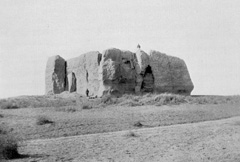

Stein's 1907 photograph (left) of T.XIV and the author's 1989 photograph (right), showing the extensive restoration. Copyright: The British Library (left) and C. W. Dyment (right)
Similarly, sheltered in a dry depression close by, the adjacent section of the wall, which Stein remarked was 'in an excellent state of preservation' [Ibid. vol. 2, pp. 681-2.], remains in its pristine state; here are the layers of reed fascines and stamped clay just as he described them [Ibid. vol. 2, fig. 176 and Dyment 13 & 14.].
In outline the magazine also seems well-preserved, its main structure still largely reflecting Stein's record of it [Ibid. vol. 2, fig. 186 and Dyment 19].
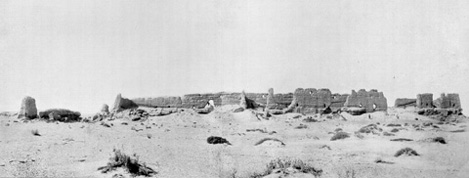
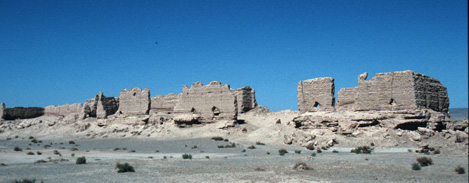
1907 (top) and 1989 (bottom) photographs of the magazine. Copyright: The British Library (Stein photograph) and C. W. Dyment.
But detailed study of the 1989 photographs and of the state of the interior suggest that some erosion of this immense structure has occurred over the century, what remains is still impressive and is clearly worthy of managed preservation [Dyment 20.].
This is a cue for some personal observations. The 8th century Tibetan fort near Miran [See Stein 1912 op. cit. vol. 1, ch. 38; Stein 1921 op. cit., vol. 1, ch. 12; and Susan Whitfield, Life Along the Silk Road, John Murray, London 1999, pp. 55-75.] is set in a landscape of quite stunning grandeur, a moonscape (in Stein's words a 'terribly barren plain' [Stein 1912 op. cit., vol. 1, p. 439.]) stretching south to the Kunlun range on the horizon. Similarly the magazine, some 180 m. in length, makes an overwhelming impact, enhanced by its setting in a great marshy depression below the level of the surrounding desert and overlooked by several watchtowers. At both sites our expedition members were alone. The Chinese authorities' concern over national security in the Lop Desert near Miran and treasure-hunters at all these 'ancient sites' are understandable; but the recent escalation of Stein studies and the current wide interest in his explorations (barely nascent in 1989) ought now to stimulate intelligent exploitation of tourism to provide the resources for preservation of these extraordinary remains.
Ed. Note: The author has kindly agreed that his 1989 photographs of the Limes can be added to the Dunhuang database and they will be available for viewing later this year along with the Stein photographs on the IDP Web Database.
Conservation and Science
Following the report in the last issue of the properties of Melinex for conservation use, the following article is a summary by David Jacobs, a conservator at the British Library, of the results of the analysis carried out by the Laboratory of the Government Chemist (UK) on samples of Melinex used to house Chinese papers. The reason for the analysis was that some Melinex was showing blemishing and it was considered vital to discover the reasons for this.
Six samples were submitted to the laboratory for testing, five of which were blemished samples of Melinex and the last a control sample. Samples 1, 5 and 6 were examined by Scanning Electron Microscopy (SEM) (see below) and Infra-red Spectroscopy (IR), and samples 5 and 6 by X-ray Photoelectron Spectroscopy (XPS).
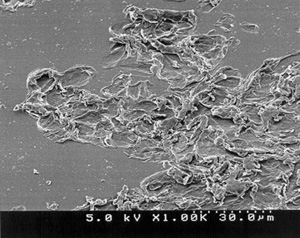
SEM at x1000 of Sample 5 showing clearly pits and blemishes on the Melinex.
White patches were found only the inside of the Melinex film and gentle polishing with a tissue did not remove them, indicating that they were not deposits. The optical micrograph suggested that they are the result of mechanical abrasion, a view confirmed by electron micrographs. At low magnification (x50) the patches are very obvious and at a magnification of x1000, pits and raised portions in the polymer surface are already visible. In one pit SEM found evidence of a silica particle. Differences between the infra-red spectra obtained from blemishes and from clear areas of the film are also consistent with physical damage and were readily reproduced by scratching the surface of the Melinex with a scapel blade.
In addition to the carbon and oxygen expected from the polymer, elemental analysis from the SEM showed the presence of chlorine and potassium, and in one area silicon with traces of sodium, chromium, iron and copper. Chlorine, potassium, sodium and silicon, and additionally sulphur were also seen by XPS. XPS further determined the silicon, sulphur and chlorine to be present as species in inorganic compounds, the sulphur being sulphate. It is probable (although not proven) that silica, and chlorides and sulphates of sodium and potassium are the species present. These would be expected from the environment of the samples: silica particles and sulphates present in the dust from the cave walls, and chlorides either from the same source or from human contact, or both.
XPS and IR detected organic matter on the sample, albeit at relatively low levels. This material contains hydoxyl groups but its structure could not be elucidated further from the data obtained.
It is hoped that in the future funding will be found to enable further analysis to:
i. determine if abrasion is the major cause of the blemishes
ii. determine the depth of the abrasion by examination of cross-sections of film through the blemish areas and so to determine the probable effect on the integrity of the Melinex film
iii determine the nature of the organic contamination layer through further IR spectroscopy on both sides of the film.
The XRD analysis indicated the presence of some polymer crystallinity of the control sample typical of PET Melinex. Sample 5 showed an XRD peak of approximately 50% of the control sample. Reasons for this could be:
i. loss of crystallinity in the PET film
ii. dilution of the PET film by chlorine containing species
iii. the presence of a chlorine containing film above the PET film which absorbs the X-rays from the underlying PET.
Additional analysis will now be considered to clarify this observation.
In addition to the work done by LGC, Raman Microscopy was used to examine the blemishes on sample 1 and control sample 6 at the the Christopher Ingold Chemistry Laboratory at University College London. The analysis was done by Lucia Borgio. The Raman analysis showed no chemical changes in the spectrum of the PET at the blemish areas or on the surface of sample 1, or on the PET of the control sample 6.
Current Research
This is a new section of IDP News which will present brief reports of recent and current research being carried out by scholars in the field. All are welcome to contribute. Please contact IDP.
Siddhasara: A Study of Chinese Medicine Chen Ming (Department of History, Peking University)
My doctoral research at Peking University involved comparative research on classical Indian and traditional Chinese medicine. I mainly focussed on Siddharsara, the famous Sanskrit medical text compiled by Ravigupta in about the mid-seventh century, and its dissemination to and influence in Dunhuang.
My research culminated in my dissertation, 'A Study of Siddhasara', which was divided into two parts, namely a study of the text, and a Chinese translation.
After comparing this text (Si.) with the Bower manuscripts from Kucha (Bo.) and Stein Kharosthi manuscripts from Niya, I discovered that Kharosthi 720 is based on Si. 8,12, Bo. 2.11-13 and JP.90. Meanwhile Si. 28.22 and a prescription from vol. 3, ch. 91 of rGyud-bzhi, a famous Tibetan medical text, are almost identical.
I also carried out a comparison of the text with Chinese documents from Dunhuang and Turfan, to see if the Siddhasara influenced contemporary Chinese Materia Medica, and I reached the following conclusion. Although Siddhasara did not have a direct influence on Chinese traditional medical texts, indirect influence can be seen. In addition, Buddhist medicine did not follow the Ayurvedical system. Making use of ther Chinese Tripitaka, most especially Vinaya-pitaka, I have made good progress in elucidating some Sanskrit-Chinese remedy terms.
My research now will be concentrated on a thorough examination of non-Chinese medical texts, especially copies of the the bi-lingual Sanskrit-Khotanese Jivakapustaka found in Dunhuang and Turfan. My main objective is to discover the route of their dissemination and any influence they had, direct or indirect, on Chinese traditional medicine. I am also researching the history of Indian Buddhist medicine and social life as it related to medicine in Tang China.
Publications
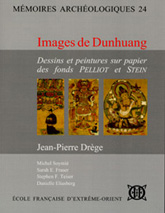
Images de Dunhuang: Dessins et peintures sur papier des fonds Pelliot et Stein
Jean-Pierre Drège (ed.) et al
école francaise d'Extreme-Orient, Paris, 1999 (Mémoires archéologiques: 24)
430 FF, 65.55 Euros
For details contact:
édition-Diffusion DE BOCCARD
11 rue de Médicis 75006 Paris, France
Tel: +44 1 43 26 00 37
Colour CD-ROM Edition of the Shogozo Scrolls
A sub-temple of Todaiji in Nara, Japan, was for over 1100 years the repository for 4960 volumes of sutra scrolls before they were donated them to the Japanese Imperial Family in 1894. Since then, the office of the Shosoin Treasure House, Imperial Household Agency, has kept, researched, and maintained these sacred scriptures. The first 21 CDs, issued now, contain the Sui and Tang dynasty Chinese Sutras (243 juan).
Japanese Yen: 1,300,000.
For details contact:
Maruzen Co., Ltd. Information Resources Navigation Division Shosoin Project-Unit
3-10, Nihombashi 2-Chome
Chuo-Ku, Tokyo
03-8245 JAPAN
fax:+81 3 3273-2097
For details contact:
the publisher.
C. G. Mannerheim in Central Asia, 1906-8
Pirjo Varjola (ed.)
National Board of Antiquities, Helsinki, 1999
Catalogue of exhibition.
For details contact:
The Museum of Culture
Etelþinen Rantakatu 8
Salomonkatu 15
FIN-00100 Helsinki, FINLAND
tel: +358 9 405 0906
fax: +358 9 405 0921
kulttuurienmuseo@nba.fi
The Lotus Sutra and Its World: Buddhist Manuscripts of the Great Silk Road
Catalogue of an Exhibition held at Soka Gakkai Josei Toda International Center, Tokyo, Japan, 10-30 November, 1998 and at Wolfenbuettel neat Hannover, Germany, 6-28 May, 2000.
St Petersburg Branch of the Institite of Oriental Studies, Russian Academy of Sciences, and the Institute of Oriental Philosophy, 1998.
The exhibition, organised by the Institute of Oriental Philosophy, Sokka Gakkai, presented 47 Buddhist manuscript and blockprints in 14 languages, including copies of the Lotus Sutra, all from the rich collections of the Institute for Oriental Studies, St. Petersburg. The catalogue,with English and Japanese text by scholars at the St. Petersburg Institute, provides an introduction and fine colour illustrations. There is also a catalogue available in German and English from the exhibition in Germany.
For details contact:
Institute for Oriental Philosophy (Toyo Tetsugaku kankyusho
1-236 Tangi-cho, Hachiji-shi Tokyo
192-0003 JAPA
fax: +81 3 426 91 6588
Between Han and Tang: Religious Art and Archaeology in a Transformative Period 3rd-6th Cent. C.E. Wenwu Press
Chinese and English with translated abstracts Papers from a conference on religious art held in November 1999.
For details contact:
Katherine Tsiang Mino
Dept. of Art History
University of Chicago
Journal of East Asian Archaeology
This journal was inauguarated in 1999 with a special volume in honour of Kwang-chih Chang, John E. Hudson Professor emeritus at Harvard University and formerly Vice President of Academia Sinica, Taipei. The journal, published by Brill, Leiden, aims to 'heighten the international visibility of the archaeological work done in this area of the world, bringing out its importance in a cross-cultural comparative context, and breaking through the language barrier that has often kept East Asian archaeology hermetically closed to non-specialist scholars.' It will publish in English.
Exhibitions
IMPERIAL CHINA: THE ART OF THE HORSE IN CHINESE HISTORY
Kentucky Horse Park, International Museum of the Horse, USA
May to August, 2000
Imperial China will be the first exhibition ever to explore the role of the horse in more than 3,000 years of Chinese history and culture. Far more than just an equestrian history, many national treasures will not only illuminate the horse's significance in art, warfare, leisure activities and sport, but also show how this interaction affected the overall culture Beginning with the Western Zhou Dynasty (1027-771 BC), and covering all subsequent dynasties through the Qing (1644-1911), the exhibition will contain spectacular artifacts, many never before seen outside of China. All of the art and artifacts have been selected from the collections of museums throughout Shaanxi Province, capital of China for more than a millennium, and home of the terracotta army of China's first emperor.
For details contact:
Bill Cooke
Director International Museum of the Horse
Kentucky Horse Park
4089 Iron Works Pike
Lexington, KY 40511, USA
Fax: +1 606 225-4613
Kentucky Horse Park
MANNERHEIM IN CENTRAL ASIA 1906-1908
The Museum of Cultures, Helsinki, Finland
This inaugural exhibition of the Museum of Cultures is the most comprehensive ever of Asian materials gathered by Carl Gustaf Emil Mannerheim (1967-1951) during his 1906-8 Central Asian expedition.
The present exhibition features a thousand ethnographical items, antiquities and texts, a thousand high-quality photographs, and some of his maps, sketches and diary entries. The exhibition runs until the end of 2000 at Finland's premier ethnographic museum, established in November 1998.
The Museum of Culture
Etelþinen Rantakatu 8
Salomonkatu 15
FIN-00100 Helsinki, FINLAND
tel: +358 9 405 0906
fax: +358 9 405 0921
kulttuurienmuseo@nba.fi
Conferences
THE INTERNATIONAL ASSOCIATION FOR TIBETAN STUDIES (IATS)
Ninth Seminar
June 2000
Leiden, The Netherlands
For details contact:
Dr Henk Bleezer
Email: IATS@Rullet.LeidenUniv.nl
DUNHUANG 2000
The International Academic Conference on the Centenary of the
Discovery of the Dunhuang Manuscript Cave (No. 17)
21-25 June, 2000
Capital Normal University, Beijing, China
For details contact:
Hao Chunwen
Dept. of History
Capital Normal University
BEIJING 100089
The People's Republic of China
Tel: +86 10 6890 3561
Fax: +86 10 6890 2315
Email: Haochunwen@ihw.com.cn
OR Haocw@mailhost.cnu.edu.cn
DUNHUANG 2000
INTERNATIONAL CONFERENCE ON DUNHUANG STUDIES
25-27 July
Hong Kong
29 July - 3 August, 2000
Dunhuang, China
The main conference is scheduled to last six days, the first four days for papers and discussion and the last two days to include visits to the Mogao caves, Yulin caves, West Qianfodong, Yumen Pass and the Han dynasty Great Wall. Spaces are limited to 170 delegates. Participants will be expected to pay a registration fee (which includes local travel for the cave visits), travel to and from Dunhuang, accommodation and other expenses. Further details will be sent with the second announcement in August. It will be preceded by a conference in Hong Kong (hkipcc@netvigator.com)
For details contact:
Mr Zhang Xiantang
Assistant Secretary General
Commission of Academic Research
Dunhuang Research Academy
Mogaoku, DUNHUANG 736200
The People's Republic of China
Tel: +86 937 886 9027
Fax: +86 937 886 9028
Email: dhbhlz@public.lz.gs.cn
36th ICANAS
27 August - 1 September, 2000
Montreal
From Dunhuang to Kucha, from the Han to the Northern Song
Dunhuang and Turfan Symposium of the International Dunhuang Project and the Groupe de recherche sur Dunhuang, Instituts d'Extreme-OrientIn continuation of the last Dunhuang - Turfan Symposium, held with great success as part of the 35th ICANAS in Budapest 1997, we would like to invite you to take an active part in the next symposium to be held in Montreal 2000.
Existing panels include:
Cross-cultures 1: Monks and Merchants
Cross-cultures 2: Property and Techniques
Dunhuang Calendars
A Comparitive Evaluation of the Qin-Han and Dunhuang Manuscripts on the Mantic Arts
Text and Image at Dunhuang and Turfan
Buddhist Apocrypha
Digital Reconstruction and Computers in Art History
Daoist Texts
Turfan Manuscripts
Problems of Restoration and Conservation
Please send your paper or panel proposals to any of the organisers as soon as possible. The symposium is part of the 36th ICANAS and participants will be expected to register for this and will receive all general details from the ICANAS organising committee.
(WWW: http://www.bcoc.umontreal.ca
Email:congres@bcoc.umontreal.ca)
A second circular and further details will be sent after the preliminary programme of the symposium has been fixed.
Organisers of the Special Symposium:
Professor Jean-Pierre Drege
Unite mixte de recherche Civilisation chinoise
Groupe de recherche sur Dunhuang
Instituts d'Extreme-Orient
52, rue du Cardinal Lemoine
75116 Paris
Fax: +33 1 44271854
Email: jpdrege@ext.jussieur.fr
Dr Simone-Christiane Raschmann
Katalogisierung der Orientalischen
Handschriften in Deutschland Arbeitsstelle Berlin II: Turfanforschung
Unter den Linden 8, D-10109
BERLIN, Germany.
Fax: +49-30-20370 467
Email: raschmann@bbaw.de
BETWEEN HAN AND TANG
RELIGIOUS ART AND ARCHAEOLOGY IN A TRANSFORMATIVE PERIOD 3RD-6TH CENT. C.E.
2nd Conference: Art and Cultural Interaction
July 2000
Peking University, China
For details contact:
Katherine Tsiang Mino
Dept. of Art History
University of Chicago
PERMANENT INTERNATIONAL ALTAISTIC CONFERENCE (PIAC)
43rd Meeting
3 - 8 September, 2000
Belgium
'Life and Afterlife and Apocalyptic Concepts in the Altaic World, Meeting in Memory of Two Founding Fathers, Charles de Harlez de Deulin (ob. 1899) and W. Bang-Kaup (ob. 1934).'
For details contact:
Secretary General PIAC
Goodbody Hall 157
Indiana University 1011 E. Third Street
Bloomington Indiana 47405-7005 USA
Fax: +1 812 855 7500
Email: sinord@indiana.edu
CONFERENCE AND WORKSHOP ON DUNHUANG MEDICAL MANUSCRIPTS
9-10 September, 2000
Cambridge and London, UK
For details contact:
Vivienne Lo
Centre for the History and Culture of Medicine
SOAS
Thornhaugh Street London WC1H 0XG
Fax: +44 20 7436 3844
Email: viv.lo@iname.com
Project News
People

Left:The delegation at the British Library (from l. to r.): Shi Pingting, Ma Wenzhi, Chen Qiliang, Brian Lang, Zhang Wenwu, Fan Jinshi, Zhang Xuzhong and Colin Chinnery.
A delegation from the Dunhuang Academy and Gansu Provincial Government visited the British Library for one week in late January. Professor Fan Jinshi, Director of the Academy, and Professor Shi Pingting, former Head of the Manuscripts Department, were invited by the International Dunhuang Project to look at Stein materials in the UK. They were accompanied by Chen Qiling, Ma Wenzhi, Zhang Wenwu and Zhang Xuzhong of Gansu Provincial Government. During their time in the UK, the delegation visited the British Museum to view Stein Dunhuang paintings, the Victoria and Albert Museum to see Stein textiles, and the Bodleian Library, Oxford, to examine Stein's dairies. The days at the British Library were spent looking at manuscripts and Stein photographs, and visiting the Conservation Studio. They also met the Chief Executive of the British Library, Brian Lang, to discuss possible collaboration on a future exhibition. Professors Fan and Shi gave public lectures at the Library on aspects of the caves' conservation and on Dunhuang manuscripts in Gansu Province respectively. Before leaving for Paris, the delegation also had the chance to see some of the sights of London.
Li Jinxiu, Institute of History, Chinese Academy of Social Sciences, Beijing spent four months at the British Library in London from November 1999 to March 2000 under the auspices of the K. C. Wong Fellowship scheme to study Dunhuang manuscripts. Her particular research project is the history of the Tang and Five Dynasties periods.
Professors Alan Arrault and Guo Zhengzhong were the first in the series of visitors to the British Library to examine Dunhuang documents under the Research Project 'Divination, Science, and Society in Medieval China'. The Project, with a steering committee consisting of Professors Jao Tsung-I, Rong Xinjiang, Donald Harper, Jean-Pierre Drège and Marc Kalinowski, will result in a three volume publication providing the specialist with a reference work for easy access to the manuscripts under scrutiny, and is supported by Ecole Pratique des Hautes Etudes (EPHE), Ecole Francaise d'Extreme Orient (EFEO) and Centre de recherches Civilisation Chinoise, all in Paris,and the Institute of Chinese Studies and the Centre for Dunhuang and Turfan Studies at the Chinese University of Hong Kong.
Professor Takeuchi Tsuguhito spent one week at the Library in February examining manuscripts and discussing his future collaborative cataloguing work on the Stein Tibetan woodslips. Professor Matsuda Kazunobu of Bukkyo University, Kyoto, has agreed to produce a catalogue of the Stein Sanskrit materials for the British Library. Mariner Padwa spent three weeks with IDP in February working on the Stein Kharosthi documents from Niya and adding material to the database. We would like to thank him for his work.
Staff
Sam van Schaik, who works on Tibetan material for IDP, successfully completed his viva for his doctorate on Tibetan Buddhist studies with the University of Manchester, UK. We offer Dr van Schaik our congratulations.
Colin Chinnery and Susan Whitfield attended the conference of the Pacific Neighbourhood Consortium (PNC), Electronic Cultural Atlas Initiative (ECAI) and Electronic Buddhist Text Initiative (EBTI) held at the University of California at Berkeley in January 2000. They made a joint presentation on 'The International Dunhuang Project: Recent Developments of the Web Database.' This was followed in March by a lecture tour of the US, visiting Harvard, Columbia, Princeton, Stanford and Berkeley, and also the Association of Asian Studies in San Diego to talk further on 'Mapping Dunhuang and Central Asian Antiquities: An ECAI Exemplar Project'.
Mellon Foundation
In April, the British Library received support from The Andrew W. Mellon Foundation to prepare high quality digital images of selected Dunhuang manuscripts from the Library's collections. The images will be included in a prototype system that Professor Sarah Fraser of Northwestern University is developing, also with the support of the Mellon Foundation, for linking two- and three-dimensional digital representations of Dunhuang cave art and associated manuscripts, textiles, and paintings from libraries and museums around the world. The prototype is being prepared for demonstration at the Centennial Celebration in Dunhuang at the end of July 2000 and at the Beijing Dunhuang conference in late June.
OTHER NEWS
Anna-Grethe Rischel from the National Museum of Denmark spent three days in the Conservation Studio of the British Library in March this year examining five fragmentary manuscripts from sites at Loulan (Or.8210/480-484, Maspero Nos. 169-173). During the examination of the fragments it became apparent that the five fragments formed one single manuscript. Small samples were taken for Dr Rischel to carry out further fibre analysis. Dr Rischel's work is part of a larger project based on 23 Loulan documents in the Sven Hedin collection in Stockholm. They have been carefully studied by Professors Umehara Kaoro and Tomiya Itaru from Kyoto and their results, along with those of Dr Rischel's analysis on the Hedin and Stein documents, will shortly be published. Details of the publication, a photograph of the document, and the results of Dr. Rischel's analysis will be carried in a future issue of IDP News.
